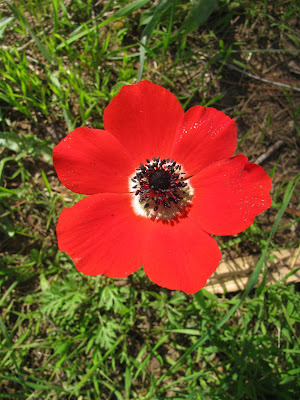The Pura Reserve, or "Shmurat Pura" in Hebrew, is named after the ruins of an ancient village named Pura on the western edge of the reserve. It is called Hirbat al-Fura in Arabic. The reserve has plants of Mediterranean and desert origin, including the Anemone coronaria, or kalanit as it is known in Hebrew, a flower which grows wild all over Israel during the winter months. The annual "Darom Adom" or "The Red South" festival celebrates this spectacle of Israel’s national flower being in full bloom, as well as Israel’s agricultural achievements more generally. Other flowers found in the reserve include buttercups, poppies, large asphodels, Anchusas, mandrakes and others.
A half hour walk westward took us further into the reserve and towards a demolished bridge, above, the remains of a Turkish railway track that was paved during World War I. The track once connected Be'ersheva with Lod, continuing in the direction of Sinai and the Suez Canal, which was under British control. The bridge, which was once a great feat of engineering, was in use until 1927 and was destroyed by floods in the 1970s. Looters of building stones have not left much of it.
Farther west there is a climb to Tel Nagila, a settlement that was established in the Chalcolithic period, though we didn't make it quite that far on the day we visited. At the top of the tel, or mound, there is a lone tamarisk tree, which can be seen from far away, and the views, including other ancient mounds - Hasi and Keshet to the north, and Malha to the west - are supposed to be wonderful.
Remains of a community more than five thousand years old were discovered at Tel Nagila, as well as an inn from the Middle Ages and remnants of a Bedouin community. According to a Bedouin legend, the Turkish army buried a treasure of coins at the foot of the mound.
Large sections of the area around the Pura Reserve are agricultural areas, and have not been marked or declared a nature reserve. The farmers who live in the region have at present agreed to conserve the landscape and refrain from inappropriate development that could mar it. I very much hope it stays that way.
After a few hours of walking and picnicking (and watching the spectacle of a 4x4 being pulled out of the muddy waters below the Turkish railway bridge by another vehicle) it was time to move on. We planned to stop by Noam's Artichokes at Moshav Nir Banim to pick up a box of the delicious edible thistles. The artichokes, just harvested, are fresh and crispy and nothing like the artichokes you find elsewhere. Boiled until tender and then cooled in a little cold water and drained, we ate them dipped in butter and lemon juice that night. Delicious!
Finally, no connection to the Pura Nature Reserve but Israel-related all the same, 2017 marks 50 years of Kibbutz volunteering. The Kibbutz Volunteers Program Center are in the midst of planning anniversary events, but are also attempting to reach an ambitious goal for this year: They want to see at least 950 Kibbutz volunteers throughout 2017. Why? Because they set a goal of additional 300 volunteers to the 650 volunteers they had in 2016.They have asked people to spread the word and, since I live in Israel and often write about many of the wonderful places I have visited here, I am happy to do my bit to help.
"We absorb individuals, couples, and groups (18-35) to Israel to experience the land, culture, and people. The program is for a period of 2-12 months.
You already know that volunteering on a Kibbutz is one of the most cost effective and fun ways to visit Israel. Volunteers have the opportunity to choose a Kibbutz and work directly alongside locals. Great opportunities are awaiting our volunteers: practical skills, travel Israel, make new friends from all around the world, tons of fun and work in a diverse multicultural context.
Our volunteers become goodwill ambassadors of Israel upon returning to their home country. They are able to provide an accurate view of Israel to their social group back home. Volunteers are both crucial in helping to tell the story of Israel, as well as present and educate locals and fellow volunteers about their own countries."
Check out the Kibbutz Volunteers Program Center (KPC) website for lots more information.
* This post has been shared on Floral Friday Fotos, Floral Bliss, Friday Foto Friends, Monday Mellow Yellows, Sunday Snap, Scenic Weekends, Sundays in my City, Sunday Pleasure, The Good. The Random. The Fun., Monday Morning Blog Club, Monday's Musings, Amaze Me Monday, Seasons, Wordless Wednesday (on Tuesday), Pictorial Tuesday, Our World Tuesday, You're the Star Blog Hop and Travel Tuesday.
* This post has been shared on Floral Friday Fotos, Floral Bliss, Friday Foto Friends, Monday Mellow Yellows, Sunday Snap, Scenic Weekends, Sundays in my City, Sunday Pleasure, The Good. The Random. The Fun., Monday Morning Blog Club, Monday's Musings, Amaze Me Monday, Seasons, Wordless Wednesday (on Tuesday), Pictorial Tuesday, Our World Tuesday, You're the Star Blog Hop and Travel Tuesday.


















































15 comments:
What a stunning place, and your photos are absolutely beautiful #MMBC x
So pretty and lush!
Beautiful landscape. I love a field of poppies! The volunteer program sounds wonderful and so fulfilling. I have never seen an artichoke plant before. It is neat seeing how they look before being picked. :)
It's wonderful when mother nature sends flowers bursting from the ground.
The Pura Reserve is a beautiful & interesting place to visit. I loved the sight of merry red poppies or anemones in the middle of the grass. Artichokes are such handsome plants with their greyish foliage. Thank you so much for linking - wishing you a great week!
Subtitled Beauty blooms in the desert, Lisa! :) :) I do hope you get your kibbutz volunteers!
Looks like you both enjoyed the trip. How nice to have anemones blooming in the wild - we have to buy then here! But we do have poppies in California. The Suez canal - I went through there when I was 5 years old (when 1000nds of people left Indonesia to go to Holland with big ocean liners). Thank you for sharing this lovely spring post with SEASONS, Lisa! Enjoy your week:)
What a lovely reserve!
How fun to travel with you through your photography. The leaves on the yellow flowers reminds me of large clover leafs. Enjoyed visiting. Sounds like a fun day. :)
Peabea@Peabea Scribbles
Wonderfull photos of nature.
The volunteer program is great. Love to read about it.
How nice are the calaniot. I love their bright red color! Their heart is white? I think it is so nice to see how they cover the southern fields. Is it warm there? I like also the "asphodelus ramosus". Very, very big plants! Thanks for sharing the beautiful photos.
Hi Lisa, the Pura Reserve sounds like an interesting place to explore and pretty spring flowers are always a pleasure to see. We see asphodelus ramosus growing wild around here, it is going to make me wonder if they were planted along time ago to mark someone's grave. I do hope the farmers stand by the decision not to overly develop the area.... My husband spent a few months working on a Kibbutz and relly loved it.
Thank you for linking up with the #MMBC.
xx
What stunning poppies at the nature reserve. They almost look like they have been made out of paper as they look so perfect.
Wonderful place - I love the artichokes and scarlet flowers too!
Poppies are one of my favourite flowers. Sadly, apart from the Californian variety, I have great difficulty growing them in my garden. I think I need a nearby nature reserve! xx
Post a Comment